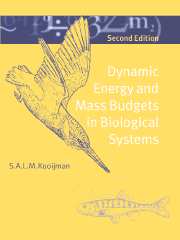Book contents
- Frontmatter
- Contents
- Preface to the second edition
- Preface
- Book organization
- Acknowledgements
- 1 Energetics and models
- 2 Basic concepts
- 3 Energy acquisition and use
- 4 Uptake and use of essential compounds
- 5 Multivariate DEB models
- 6 Uptake and effects of non-essential compounds
- 7 Case studies
- 8 Comparison of species
- 9 Living together
- 10 Evaluation
- Bibliography
- Glossary
- Notation and symbols
- Taxonomic index
- Subject index
9 - Living together
Published online by Cambridge University Press: 12 March 2010
- Frontmatter
- Contents
- Preface to the second edition
- Preface
- Book organization
- Acknowledgements
- 1 Energetics and models
- 2 Basic concepts
- 3 Energy acquisition and use
- 4 Uptake and use of essential compounds
- 5 Multivariate DEB models
- 6 Uptake and effects of non-essential compounds
- 7 Case studies
- 8 Comparison of species
- 9 Living together
- 10 Evaluation
- Bibliography
- Glossary
- Notation and symbols
- Taxonomic index
- Subject index
Summary
The primary purpose of this chapter is to evaluate the consequences of the DEB model for individuals at the population and higher levels if extremely simple rules are defined for the interaction between individuals and the energy balance of the whole system. The first section deals with trophic interactions between species, and the constraints on parameter values that ensure a stable coexistence. Then follows a discussion of population dynamics, food chains and (simple) ecosystems.
Trophic interactions
The DEB theory can be used to analyse the dynamics of systems with complex types of mass exchange between the participants in trophic relationships, a rich spectrum ranging from competition to predation. The present aim is to discuss some constraints in these patterns that ensure weak homeostasis of structural masses: the relative abundance of the structural masses of the participating species is independent of the substrate densities in the environment at steady state.
Trophic relationships are hard to classify; all relationships seem to be unique at close inspection. They are usually based on the judgement of being beneficial for one or both partners, and many different definitions exist for particular inter-species relationships. The oxpecker Buphagus feeds on insects that are attracted to wounds of giraffes, antelopes and other bovids; it is not difficult to see why the thin-skinned small antelopes make evident that they do not really appreciate this ‘help’ from the birds: oxpeckers try to keep wounds attractive for insects. I observed what solution oxpeckers have when wounds are in short supply. I will refrain from a judgement of benefits, and discuss the various relationships purely on the use of substrates.
- Type
- Chapter
- Information
- Dynamic Energy and Mass Budgets in Biological Systems , pp. 301 - 356Publisher: Cambridge University PressPrint publication year: 2000



